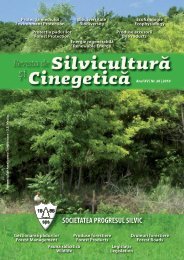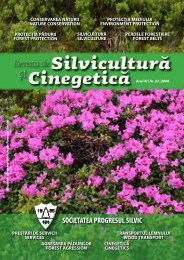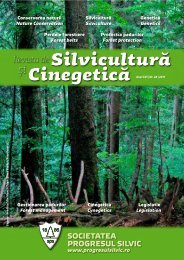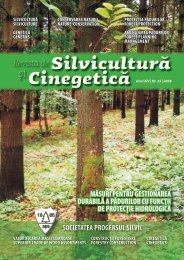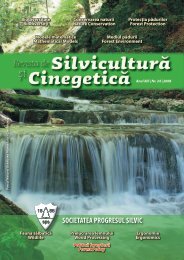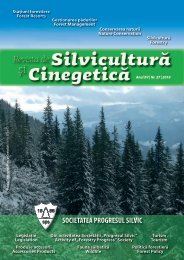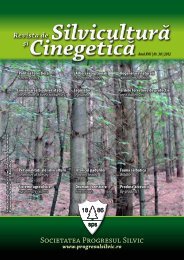Silviculture and Cinegetics Review - Societatea Progresul Silvic
Silviculture and Cinegetics Review - Societatea Progresul Silvic
Silviculture and Cinegetics Review - Societatea Progresul Silvic
You also want an ePaper? Increase the reach of your titles
YUMPU automatically turns print PDFs into web optimized ePapers that Google loves.
FORESTRY BELTS SILVICULTURE AND CINEGETICS REVIEW XVII/30/2012<br />
Apart of the l<strong>and</strong> boundaries, several necessary details<br />
for forest shelterbelts settlement of these plans are<br />
used, such as:<br />
-watercourses, canals, ponds, polders, springs,<br />
(existent) retention basins;<br />
-terrain differentiation by l<strong>and</strong> use (agriculture,<br />
forests, forest shelterbelts, tree clumps, orchards <strong>and</strong><br />
.<br />
vineyards) <strong>and</strong> highlighting cadastral units (plots,<br />
parcels);<br />
-built settlements areas <strong>and</strong> various social <strong>and</strong><br />
economical objectives;<br />
-railways, highways, communal roads, plot roads,<br />
aerial lines (telephone, electric)<br />
Fig. 1. Different information layers overlapped in<br />
the GIS analysis framework<br />
After obtaining the topographic plan, it is compulsory<br />
a preliminary l<strong>and</strong> recognition in order to collect the<br />
general data, taking into consideration the followings:<br />
- soil data (identifying the type <strong>and</strong> the general<br />
characteristics);<br />
- data regarding the forms, degrees <strong>and</strong> extension<br />
erosion process on the corresponding territory;<br />
- data regarding the trees <strong>and</strong> shrubs forest species<br />
existent in the region (insisting on the vegetation<br />
status <strong>and</strong> the productivity achieved by the forest tree<br />
species);<br />
- data regarding the local possibilities to produce<br />
necessary seedlings for forest shelterbelts<br />
establishment;<br />
- data regarding the existent hydrological network <strong>and</strong><br />
the waterground availability.<br />
3. Results <strong>and</strong> discussion<br />
3.1. Recommended afforestation solutions under<br />
the soil <strong>and</strong> ecological site conditions reflected by<br />
the existent information<br />
The distribution <strong>and</strong> the combination method of the<br />
ecological site factors within the Danube Plain <strong>and</strong><br />
Dobrogea, determine also the diversity of<br />
afforestation solutions suitable for establishing the<br />
forest shelterbelts.<br />
To implement the technical solutions for shelterbelts<br />
achievement, it is necessary a general framing of<br />
ecological site conditions for the analyzed area,<br />
starting with the assumption that the soil type is a<br />
good enough indicator to frame it in the bioclimatic<br />
zonality. At this stage an important phase is to<br />
establish the dominant soil types at the level of all the<br />
administrative-territorial units (based on the<br />
information provided by the pedological map scale<br />
1:200000, carried out by the Research Institute for<br />
Pedology <strong>and</strong> Agrochemistry).<br />
The afforestation solutions are determined on soil<br />
types <strong>and</strong> soil types groups ecologically similar,<br />
linking the ecological requirements of species with<br />
the ecological soils characteristics, but taking also into<br />
consideration the fact that by their location in the open<br />
field <strong>and</strong> by their reduced dimensions the forest<br />
53



